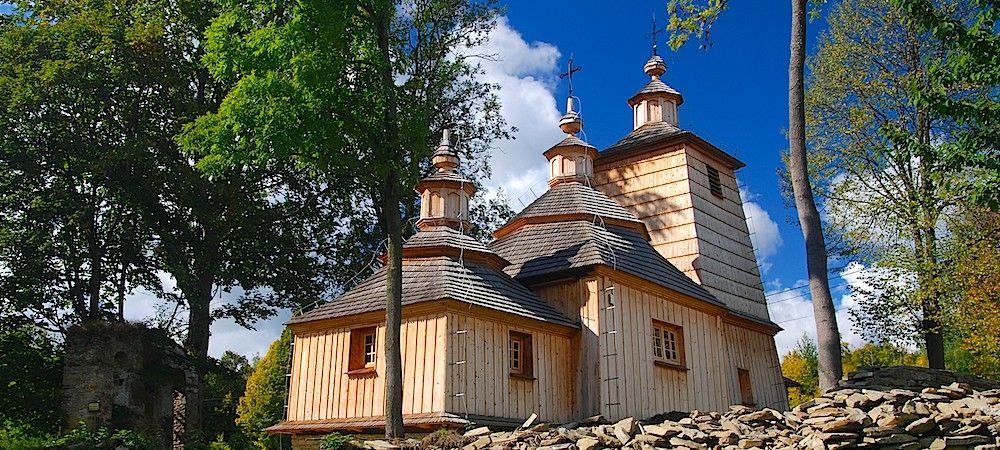
Bałucianka
A visit to Bałucianka will give you a taste of what it is like to wander around the Beskid Niski mountain range. At the same – with the beautiful Orthodox church and charming hills surrounding it – it is a tasty morsel in itself.
This island of the magical Land of Gentleness is only half an hour’s drive away from the centre of Krosno. It has kept memories of the displaced Lemkos, and evokeswonder at the richness of nature and longing for carefree wanders in the Beskid.
Bałucianka has always been connected to Rymanów. Established under the Vlach law in the 15th century by the Siesieński family, the lords of Rymanów, like every village established under the Vlach law it became in time part of the land of Ruthenian highlanders who formed the Lemko community in the Beskid Niski. A testament to that is the outstanding wooden Orthodox church of the Dormition of the Mother of God, formerly a branch of the Deszno parish. Built in the 17th century, it is one of the oldest and best preserved Orthodox churches in the entire Lemko region, whose beauty is emphasised by the charming wild stone wall surrounding it.
Looking at it today, it is difficult to believe that only a few years ago this beautifully restored pearl of wooden architecture was in a disastrous state. Fortunately, the Conservator intervened in time to save the building. Parts of its original interior have survived, including the Rococo altar from 1783 and the recently renovated iconostasis, created from two iconostases, one from the middle of the 17th century and one from the beginning of the 18th century. The most valuable element of the interior – the holy doors from the 15th century – can be viewed in the Rural Architecture Museum in Sanok.
The iconostasis, richly decorated with woodcarving using floral motifs, reminds visitors that woodcarving was one of the traditional Lemko crafts, and its form favourite with Lemkos was low relief carving with floral motifs. Lemko masters carved leaves of various trees (oak, maple, sycamore), bunches of grapes and flowers to decorate everyday objects such as wooden chests, dressers, spoon holders, trays and plates. This form of art was especially developed in Bałucianka, and when the nearby Rymanów became a health resort thanks to Anna and Stanisław Potocki, woodcarving turned out to be very attractive for its visitors. Anna Potocka was so interested in the talent of the Lemko artists that in 1878 she opened a school in Rymanów that was to teach carpentry and woodcarving. It was a success and contributed to the popularisation of carving in the entire neighbourhood of the resort. The tradition is still continued in Bałucianka by Józef Łoś, whose works are a perfect souvenir from the region, especially if you take part in workshops he runs.
A visit to the Orthodox church and the nearby graveyard (where you can see beautiful examples of Lemko stonework can be a starting point for an interesting, though not very challenging, hike or bicycle ride up the Przymiarki.
Przymiarki is a low mountain ridge rising 626 metres above sea level. It is an excellent viewpoint with a panorama of the Strzyżowsko-Dynowskie Foothills, the hills around Rymanów, the Krosno Basin and of course the Beskid Niski mountain range, with a clear view of the Pasmo Graniczne and Gniazdo Jawornika, as well as the Beskid Dukielski with the majestic Cergowa Mountain. On a clear day, a climb up Przymiarki is also rewarded with a view of the Tatra Mountains; if the weather is not so good, you may only see the no less interesting panorama of the Bieszczady Mountains.